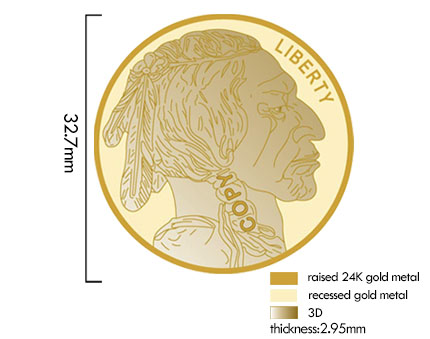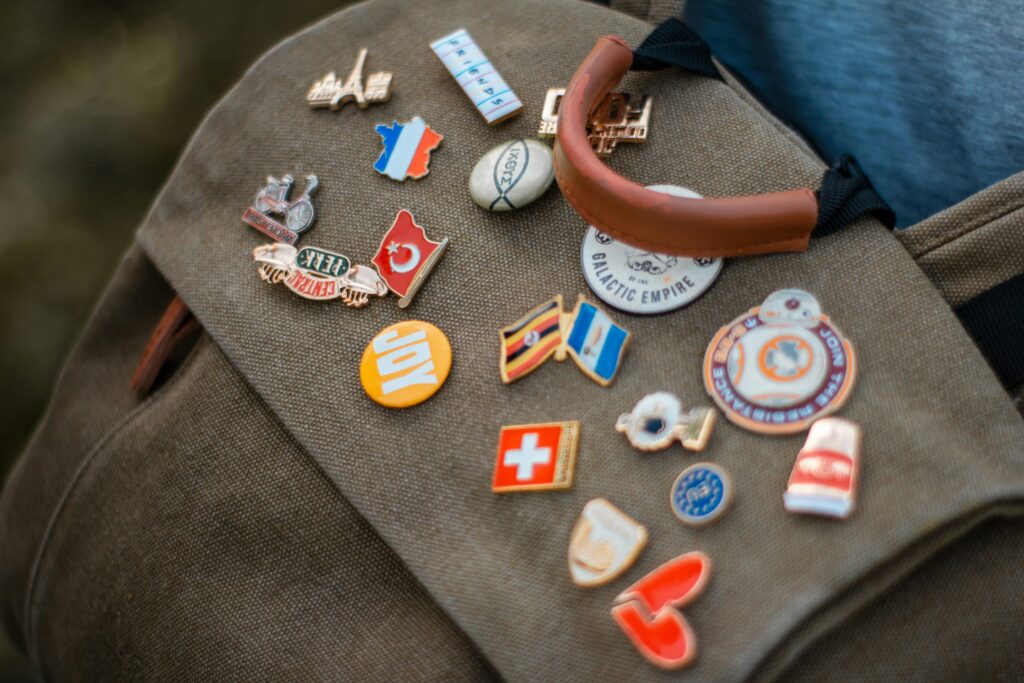Creating metallic pins is a fascinating process that combines artwork with manufacturing techniques. From easy designs for nearby clubs to intricate creations for corporate activities, steel pins serve as a versatile medium for self-expression and branding. The first step in developing those small but impactful objects is to understand the differing types or varieties of pins, which include soft enamel pins for a textured experience or hard enamel for an easy, polished finish.
Moving on from the conceptual degree, designing custom metal pins requires careful consideration of size, color, and detail to ensure the final product meets the supposed vision. Once a design is finalized, the manufacturing process entails deciding on the perfect materials and strategies for bringing it to life—this will imply stamping the design onto a delegated metal and filling the recessed areas with enamel or various other techniques, depending on the preferred outcome and complexity of the layout.
Understanding Metal Pins
Metal pins, often referred to as enamel pins, are small, decorative items traditionally used to adorn garb, backpacks, and other fabric-based items. They are created by infusing colored enamel into recesses in a metal base, generally shaped consistent with a design or logo. The metal offers a sturdy basis and gives the pin its form and weight.
Materials: The choice of metal affects the pin’s appearance and durability. Common metals used include brass, copper, iron, and stainless steel. Each has its own characteristics—brass and copper are quite malleable; iron offers a classic look; stainless steel is known for its resistance to rust and corrosion.
Design:
- Creation: A digital design is converted into a physical form when a mold is made.
- Detail: The level of detail that can be achieved in metal pins is subject to the medium’s limitations. Fine lines and intricate patterns may not always be perfectly reproduced in metal.
- Coloring: Enamel colors are added before the pin is fired in a kiln, solidifying the enamel.
Finishing Touches: The pins are polished to a shine or given a textural finish, enhancing the visual impact. Fasteners, like a butterfly clutch or a safety pin, are then attached to the back for secure placement on fabric.
Manufacturing: They are typically manufactured in bulk through a factory process that includes stamping, plating, and filling with enamel. This process ensures uniformity and quality across large quantities.
The manufacturing of metal pins is as much an art as it is an industrial process, blending creative designs with meticulous production techniques to create items that are both personal and expressive.
Designing Custom Metal Pin

When creating custom metal pins, the process begins with a distinct idea and transitions into detailed artwork. The proper design ensures that the final product effectively captures the envisioned aesthetic and message.
Conceptualization
The initial phase in designing custom metal pins is to define the pin’s purpose. Artists must decide on themes, such as corporate branding, commemorative events, or artistic expression. They should consider factors like the target audience, the pin’s intended use, and the message it conveys. During this stage, it is crucial to determine the size, shape, and colors that will be needed, as these elements all contribute to the feasibility and visual impact of the final pin.
Artwork Creation
Once the concept is firmly in place, the actual design work begins. This typically involves sketching the design, either by hand or using digital illustration tools. The artwork must be clear and detailed, considering the limitations of metal casting and enamel filling. Lines should be bold enough to create distinct metal borders, and text must be legible even at a small scale. Artists often use vector graphic software to ensure the design can be scaled without losing detail. They need to ensure that their design is suitable for the manufacturing process, which includes selecting appropriate metal types and enamel colors that can faithfully reproduce their artistic vision.
Metal Pin Production Process

The creation of metal pins involves meticulous steps from the initial design to the final product. Each phase is crucial in ensuring that the finished enamel pins meet quality and design standards.
Material Selection
Pin manufacturers often begin by selecting the ideal steel primarily based on the design requirements and desired attributes. Stainless steel and brass are normally used due to their durability and ease of production. The choice between hard or soft enamel also plays a role in aesthetics and cost.
Shaping and Cutting
With the materials chosen, the next step is to turn the design into a metal form. It begins with crafting a precise mold and then using a process known as die striking to cut out the pin shapes from the selected metal material. The intricacy of the design dictates the complexity of the mold and the cutting process.
Coloring and Finishing
Once shaped, coloring can begin using a technique that fills recessed areas of the pin with enamel paint. Soft enamel pins provide a textured surface, while hard enamel pins offer a smooth, durable finish· After adding color, a protective coating is applied, and the pins are polished to achieve the desired sheen· The process of creating soft enamel pins often results in cheaper production costs compared to their hard enamel counterparts·
Types of Custom Trading Pin

Custom metal trading pins are collectibles that often serve as a symbol of camaraderie and team spirit, particularly in sports contexts. They come in various designs and can feature intricate detailing and vibrant colors, with options to add a range of motion or light features.
Custom Baseball Trading Pins
Custom baseball trading pins are a staple in youth league and tournament play, serving as a token of the game and often traded amongst teams. These pins typically feature team logos, mascots, or special tournament insignia and can include enhancements such as sliders, spinners, or danglers to increase their uniqueness and perceived value.
Custom Sports Trading Pins
Expanding beyond baseball, custom sports trading pins encompass a variety of athletic events including soccer, football, hockey, and more· Teams may personalize these pins with specific tournament dates, team achievements, or player numbers. A notable characteristic of these pins is their ability to unite players and fans through the act of pin trading, building memories and friendships along the way.
Ordering and Manufacturing Custom Pins
The process of obtaining custom metal pins typically starts with an idea or design. Designers or brands share their envisioned pin concepts with a manufacturer, ensuring that the visuals are clear and the desired outcome is well-communicated.
Selecting a Manufacturer
Choosing a manufacturer adept at creating high-quality metal pins is crucial. Factors such as production time, quality of materials, and cost should be considered. Companies like Lapel Pins Plus often provide detailed information on their production capabilities and timelines.
Prototyping
After a manufacturer is chosen, a prototype or sample pin may be created. This prototype serves as a tangible representation of the final product and allows for any necessary revisions before full-scale production begins·
Manufacturing
Once the prototype is approved, the producing segment starts. This degree entails carefully crafting and high-quality management of the pins, making sure each piece meets the favored specs. Metals, which include copper, brass, or stainless steel, are used, and strategies like stamping and plating are applied to achieve the final look.
Delivery
After the pins are manufactured, they go through a final inspection earlier than being packaged and shipped. Manufacturers offer fast and stable transport options to ensure the custom steel pins reach their destination in the best circumstances.
The above steps present a confident guide to ordering and manufacturing custom metal pins for businesses, artists, and individuals looking to create personalized items for branding, events, or personal use.
FAQs
What materials are needed to make enamel pins at home?
To make enamel pins at home, one needs enamel paint, pin blanks, a fine-tipped brush, and a kiln for firing if using hard enamel· Instructions specific to the type of enamel paint or technique used can provide further details·
What is the process for making custom metal pins for clothing?
The system for making custom metallic pins consists of designing the artwork, growing a mold, stamping out the layout on steel, adding enamel, and then baking the pins to harden the enamel. Each step should be cautiously performed to ensure the very last product’s satisfaction.
How do you create your own enamel pins from scratch?
Creating enamel pins from scratch involves starting with a layout comic strip, shifting it onto a steel base, after which carefully applying enamel to the recessed areas. After application, the enamel is cured through baking or air-drying depending on the type of enamel.
What equipment is necessary to start producing metal pins for sale?
Producing metal pins for sale requires access to design software, a mold-making setup, a stamping press, enameling materials, and a kiln or oven for curing the enamel· A thorough understanding of the techniques and safety measures is also essential·
Can you describe an easy method for making pins at home?
An easy method for making pins at home includes using a fine-tipped brush to apply enamel paint onto pin blanks, following specific paint instructions for curing, and then adding any final touches like a pin back·
Which type of metal is typically used for crafting pins?
The most commonly used metals for crafting pins are brass, copper, or stainless steel due to their durability and ease of working with during the stamping and enameling process·



